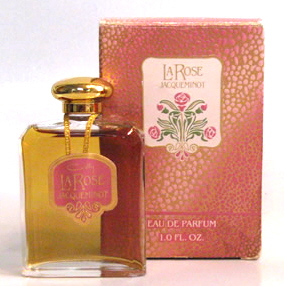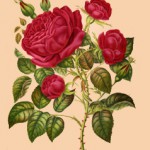Coty – La Rose Jacqueminot
For today’s post, I thought I would focus on a vintage Coty fragrance based on the flower which perhaps more than others has come to symbolize Valentine’s Day: the rose. The Général Jacqueminot rose is an early hybrid believed to have originated in Roussel, France 1853. The Jacqueminot is known for its deep red petals and intoxicating fragrance. It is this rose which was the inspiration behind Francois Coty’s creation La Rose Jacqueminot. While there is some dispute regarding the date of the fragrance’s creation (some sources indicate 1903 while others have stated a later date of 1906) what remains uncontrovertible is this: the success of Coty’s vision of the beauty and depth of this flower.
In what has become a notoriously brilliant marketing move, legend has it that Francois Coty, unable to find a store willing to carry his newly-developed La Rose Jacqueminot “accidentally” let a bottle of it drop and smash on the floor of one of Paris’s most exclusive department stores, sending the ground-breaking scent wafting through the store. Women soon crowded around, clamoring to purchase the fragrance, but whether these were innocent bystanders or “shoppers” planted by Coty, we will never know. While this may be the stuff of legend, Coty was an astute businessman who went on to become wildly successful.
The fragrance starts out with a bright mix of spicy greens and soft honey, creating the impression of a rosebud preparing to unfurl and reveal its bright petals. While some sources list La Rose Jacqueminot as a rose soliflore, I find this to be far from true. As the fragrance progresses, the honey impression is punctuated by warm Autumn spices of cardamom and clove which make for a dark and complex rose. As the fragrance warms on the skin, the spices settle and the rose becomes more subdued. Thereafter, as the more animalic basenotes of musk and amber emerge, the effect is more of a chypre tinged with rose than a true rose scent, as though the rose is simply there to temper the complexity of the chypre accords. The fragrance in the Eau de Parfum concentration is fairly long lasting, yet wears close, with a subtle silage. The vintage sample I tested is identical to the bottle displayed below.
 For the wearer accustomed to a more opulent, fruitier rose such as Nahema or YSL’s Paris, or a powdery rose like Ombre Rose, this will be a distinct departure as Jaqueminot appears drier, with more emphasis on the spice and green, plant-like aspects of the flower, than on the lush petals.
For the wearer accustomed to a more opulent, fruitier rose such as Nahema or YSL’s Paris, or a powdery rose like Ombre Rose, this will be a distinct departure as Jaqueminot appears drier, with more emphasis on the spice and green, plant-like aspects of the flower, than on the lush petals.
Notes: Rose, honey, cardamom, clove, musk , and amber.



